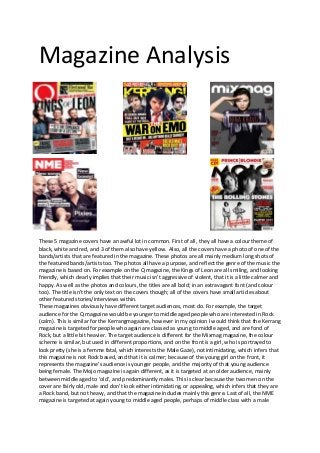
Magazine analysis coursework
- 1. Magazine Analysis These 5 magazine covers have an awful lot in common. First of all, they all have a colour theme of black, white and red, and 3 of them also have yellow. Also, all the covers have a photo of one of the bands/artists that are featured in the magazine. These photos are all mainly medium long shots of the featured bands/artists too. The photos all have a purpose, and reflect the genre of the music the magazine is based on. For example on the Q magazine, the Kings of Leon are all smiling, and looking friendly, which clearly implies that their music isn’t aggressive of violent, that it is a little calmer and happy. As well as the photos and colours, the titles are all bold; in an extravagant font (and colour too). The title isn’t the only text on the covers though; all of the covers have small articles about other featured stories/interviews within. These magazines obviously have different target audiences, most do. For example, the target audience for the Q magazine would be younger to middle aged people who are interested in Rock (calm). This is similar for the Kerrangmagazine, however in my opinion I would think that the Kerrang magazine is targeted for people who again are classed as young to middle aged, and are fond of Rock, but a little bit heavier. The target audience is different for the Mixmag magazine, the colour scheme is similar, but used in different proportions, and on the front is a girl, who is portrayed to look pretty (she is a femme fatal, which interests the Male Gaze), not intimidating, which infers that this magazine is not Rock based, and that it is calmer; because of the young girl on the front, it represents the magazine’s audience is younger people, and the majority of that young audience being female. The Mojo magazine is again different, as it is targeted at an older audience, mainly between middle aged to ‘old’, and predominantly males. This is clear because the two men on the cover are fairly old, male and don’t look either intimidating, or appealing, which infers that they are a Rock band, but not heavy, and that the magazine includes mainly this genre. Last of all, the NME magazine is targeted at again young to middle aged people, perhaps of middle class with a male
- 2. audience, and calm Rock genre because most of the people on the photo are male (there is one female), and they don’t look aggressive, so it won’t be heavy metal. These covers do also differentiate. For example, the Mixmag and Kerrang magazines use different colour schemes, and completely different photos. The Mixmag magazine has a woman posing, in comparison to the Kerrang magazine, the photo is of 3 males looking scruffy with blood on their face. The Mixmag has red, white and black coloured text/background, whereas Kerrang has red, white, black and yellow! NME and Q magazine’s photos both contain people who are smiling and looking happy, unlike the Mojo magazine with a photo of the Rolling Stones that are looking plain/dull and simply staring. Also the Rolling Stones haven’t got any colour on them, unlike the bands on NME and Q. Some magazines don’t have as much detail on the front cover as others, for example: there is a massive difference between the amount of text and photos/pictures on the cover of Mojo and Mixmag. Mixmag just has a few small articles of text on it, whereas Mojo has plenty of articles, with more text, and varied sizes, which are generally larger that the text on Mixmag. Last of all, the font of the text for the title ‘Kerrang’ is bold, with lots of cracks within it which represent danger – so does the yellow, whereas the font of the text on NME’s title is white, which has connotations of innocence, and it is plain.